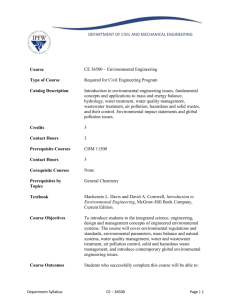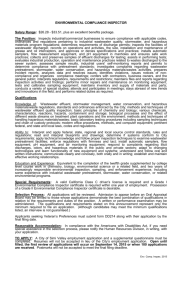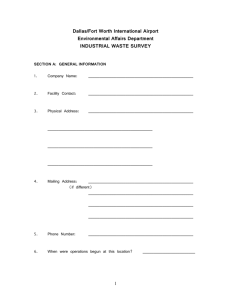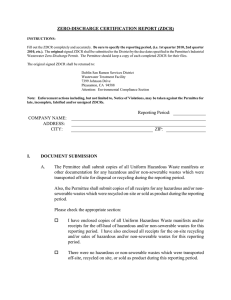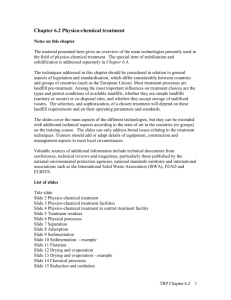Biological treatment
advertisement
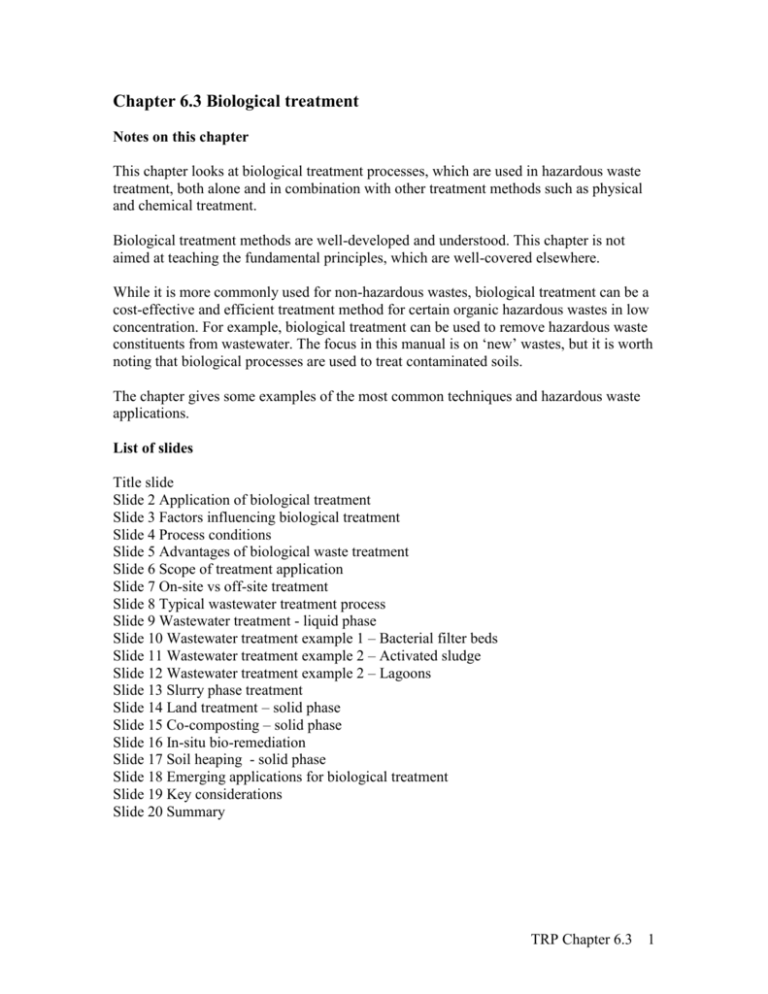
Chapter 6.3 Biological treatment Notes on this chapter This chapter looks at biological treatment processes, which are used in hazardous waste treatment, both alone and in combination with other treatment methods such as physical and chemical treatment. Biological treatment methods are well-developed and understood. This chapter is not aimed at teaching the fundamental principles, which are well-covered elsewhere. While it is more commonly used for non-hazardous wastes, biological treatment can be a cost-effective and efficient treatment method for certain organic hazardous wastes in low concentration. For example, biological treatment can be used to remove hazardous waste constituents from wastewater. The focus in this manual is on ‘new’ wastes, but it is worth noting that biological processes are used to treat contaminated soils. The chapter gives some examples of the most common techniques and hazardous waste applications. List of slides Title slide Slide 2 Application of biological treatment Slide 3 Factors influencing biological treatment Slide 4 Process conditions Slide 5 Advantages of biological waste treatment Slide 6 Scope of treatment application Slide 7 On-site vs off-site treatment Slide 8 Typical wastewater treatment process Slide 9 Wastewater treatment - liquid phase Slide 10 Wastewater treatment example 1 – Bacterial filter beds Slide 11 Wastewater treatment example 2 – Activated sludge Slide 12 Wastewater treatment example 2 – Lagoons Slide 13 Slurry phase treatment Slide 14 Land treatment – solid phase Slide 15 Co-composting – solid phase Slide 16 In-situ bio-remediation Slide 17 Soil heaping - solid phase Slide 18 Emerging applications for biological treatment Slide 19 Key considerations Slide 20 Summary TRP Chapter 6.3 1 Background notes 1 Biological treatment processes are widely used throughout the world for a variety of purposes, from treating wastewater to cleaning up contaminated soils. 2 Biological treatment may be suitable for organic hazardous wastes at low concentrations. Biological processes are never 100% efficient and this limits their application. 3 Biological processes rely on the natural actions of living organisms, but for their effective harnessing, clearly defined conditions must be present. Where conditions are outside the required range, the process will fail. 4 Biological processes may take months to reach goal concentrations of microbes – the required conditions for good microbial activity will vary according to individual organisms – and treatment may therefore take a long time. 5 Biological treatments may be used after physical or physico-chemical processes, to further refine waste streams. This is often the case with wastewater treatment processes. Industrial wastewater can seldom be treated solely by biological means. Sources of further information Batstone, R; Smith, JE & Wilson, DC editors (1989) The safe disposal of hazardous wastes: The special needs and problems of developing countries World Bank, Washington, Technical paper No 93 Vol 2 ISBN 0-8213-1144-1 (available as pdf files from www.worldbank.org/publications/) Dean, RB & Wilson, DC (Editors) (1990) Adapting hazardous waste management to the needs of developing countries, Waste Management & Research Vol 8 No 2 Guyer, Howard H (1998) Industrial processes and waste stream management Wiley ISBN 0-4712-9984-7 LaGrega, MD; Buckingham, PL; Evans, JC & ERM Group (1994) Hazardous Waste Management McGraw Hill, New York ISBN 0-07-019552-8 Lewandowski, GA & DeFilippi, LJ (1997) Biological treatment of hazardous wastes Wiley ISBN 0-471-04861-5 Technical guidelines from the Secretariat of the Basel Convention www.basel.int TRP Chapter 6.3 2
